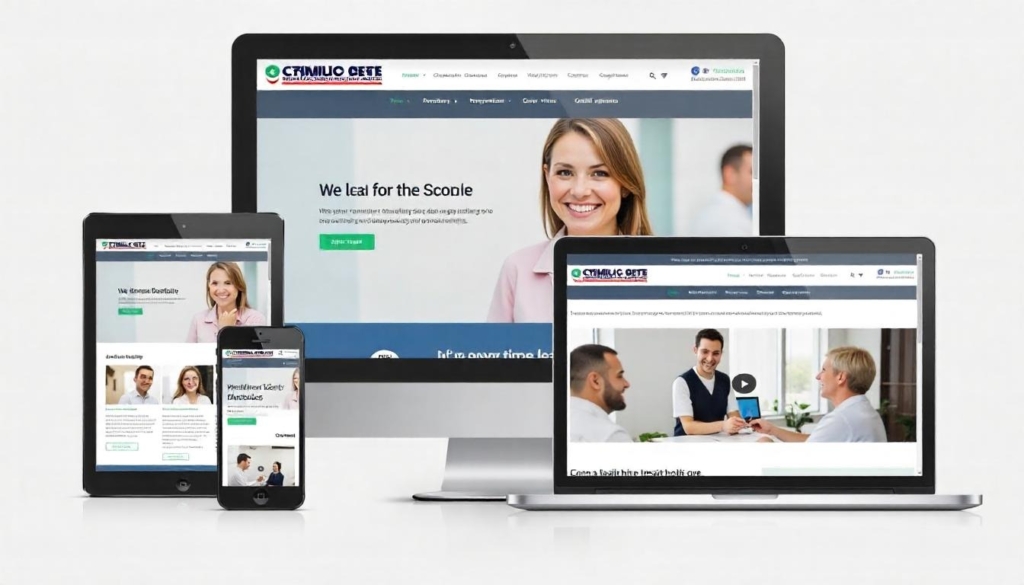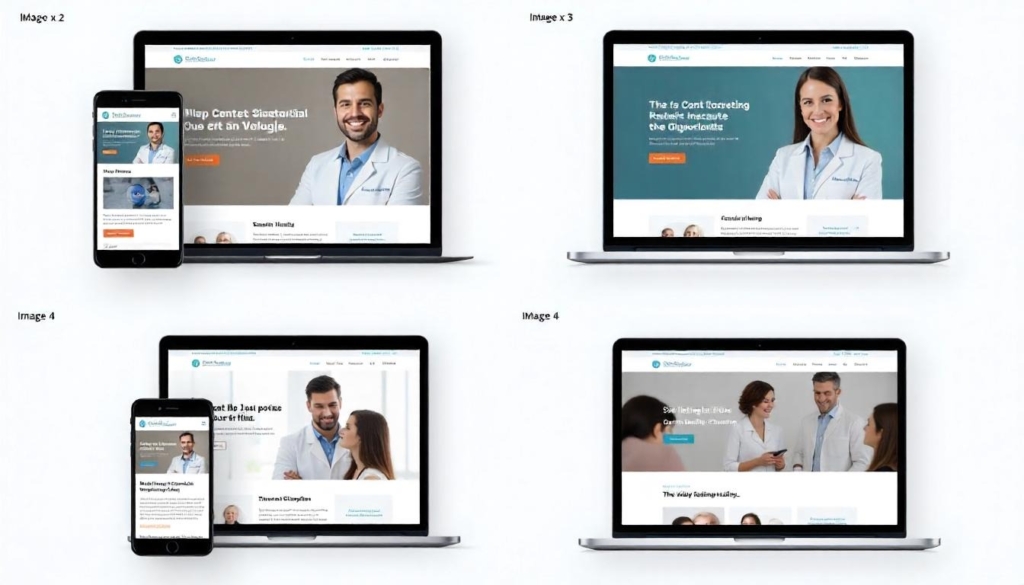In the competitive world of dentistry, having a high-quality website is no longer a luxury it’s a necessity. Your dental website is often the first interaction a potential patient will have with your practice. A beautifully designed site can boost patient trust, improve lead generation, and help grow your practice. In 2025, a successful dental website is one that balances modern design with functionality, user experience (UX), and conversion optimization. In this post, we will explore the best dental website designs of 2025, showcase standout examples, and highlight the key features that make these sites so effective.

Related Posts
- Why Dental Website Design Matters for Growth
- Turn Visitors into Booked Appointments
- Must-Have Elements That Convert Visitors to Patients
Key Elements of the Best Dental Website Designs
Clean, Modern Navigation for Easy Access
The best dental websites prioritize user experience with clean, intuitive navigation. Visitors should be able to find the information they need quickly and easily, whether it’s details about services, the team, or how to book an appointment.
Expert Insight: Well-organized navigation not only improves the user experience but also enhances the website’s SEO. Simple, clear menus and a sticky navigation bar ensure that visitors never get lost on the site.
Key design tips:
- Limit the number of menu items to make navigation easier.
- Ensure that essential information like contact details and services is easy to access.
- Use a clean, minimalist design to avoid overwhelming visitors.
Responsive Layouts – Optimizing for All Devices
With more people using mobile devices to search for services, a responsive website design is crucial. A responsive layout adjusts the website’s design to fit any screen size, ensuring a seamless experience for desktop, tablet, and mobile users.
Expert Insight: According to recent studies, over 50% of web traffic comes from mobile devices. This makes a mobile-optimized website essential for both user experience and conversion rates.
Key considerations:
- Test your website’s responsiveness across multiple devices.
- Use larger fonts and touch-friendly buttons for mobile users.
- Ensure your site loads quickly on mobile devices to prevent bounce rates.
Trust Indicators – Building Patient Confidence
For potential patients, trust is everything. The best dental websites integrate trust-building elements that assure visitors they are in good hands. This includes patient testimonials, reviews, certifications, and visible contact information.
Expert Insight: A website with visible patient testimonials and professional accolades creates a sense of authority and reliability, making it easier for new visitors to feel confident in your services.
Trust-building tips:
- Feature patient testimonials prominently on the homepage or service pages.
- Display certifications or affiliations with reputable dental organizations.
- Make it easy for visitors to contact the practice with a visible phone number and email.
Showcasing Award-Winning Dental Websites
Award-Winning Dental Websites: Why They Stand Out
Award-winning dental websites tend to share a few key characteristics: exceptional design, easy navigation, and high conversion rates. These sites often combine a beautiful aesthetic with excellent functionality, creating a seamless experience for users.
Narrative: One award-winning dental website, for instance, used a combination of minimalist design, user-centric navigation, and seamless online booking features to win a prestigious web design award. The practice saw an increase in both site traffic and patient bookings after the redesign.
Examples of standout features include:
- High-quality images of the practice and dental team.
- Easy-to-find calls-to-action (CTAs), such as “Book an Appointment” or “Contact Us”.
- Interactive elements like live chat or appointment scheduling forms.
Best Homepage Hero Sections in 2025
The homepage hero section is one of the most crucial elements of your dental website. It’s the first thing visitors see when they land on your site, and it can make or break their decision to stay. A well-designed hero section is visually striking, communicates your practice’s value, and features a clear call-to-action (CTA).
Expert Insight: A great hero section should instantly convey who you are, what services you offer, and how to get in touch. It should be clean, concise, and visually appealing to grab the visitor’s attention.
Key features of an effective hero section:
- A clear, concise headline that speaks directly to the visitor’s needs.
- Engaging visuals, such as a high-quality image of your dental practice or staff.
- A prominent CTA that encourages visitors to take action, like booking an appointment.
High-Converting Features Found in the Best Dentist Websites
Engaging Video Banners and Virtual Tours
Video content is a powerful tool for increasing engagement. Adding a video banner to your homepage or offering a virtual tour of your dental practice can help build a stronger connection with potential patients.
Expert Insight: Virtual tours offer an interactive experience that allows prospective patients to get a feel for your practice before they even set foot inside. This can alleviate anxiety and encourage them to book an appointment.
Key video features to include:
- A short, welcoming video on the homepage introduces the practice and services.
- A virtual tour showcasing the practice’s environment, equipment, and friendly staff.
- Video testimonials from patients sharing their positive experiences.
Utilizing Patient Testimonials for Social Proof
Patient testimonials are one of the most effective trust-building tools on your website. When visitors see that others have had positive experiences with your practice, they’re more likely to book an appointment themselves.
Expert Insight: The best dental websites use testimonials strategically, placing them on high-traffic pages like the homepage or service pages. Combining written testimonials with before-and-after photos or videos makes them even more compelling.
Related Posts
- Best Dental Website Design Examples 2025
- Must-Have Elements That Convert Visitors to Patients
- What to Look for in a Dental-Specific Web Designer
Key testimonial tips:
- Use real patient stories to create an emotional connection.
- Showcase testimonials across different pages, such as treatment pages or the homepage.
- Include photos or videos to make testimonials more authentic.

UX/UI Design – The Backbone of a High-Performing Dental Website
How UX/UI Influences Patient Decision-Making
User experience (UX) and user interface (UI) design are essential elements of any successful dental website. A website with excellent UX/UI helps guide visitors through the site smoothly, making it easier for them to find the information they need and take action, such as booking an appointment.
Expert Insight: A well-designed website improves patient decision-making by offering a seamless, user-friendly experience. The easier it is for potential patients to navigate your site, the more likely they are to convert into paying clients.
Key UX/UI tips:
- Keep the layout simple and intuitive, with easy-to-find CTAs.
- Use consistent fonts, colors, and styles to create a cohesive design.
- Optimize page load speeds to reduce bounce rates.
Simplifying Online Booking: Key to Conversions
A key feature of any high-converting dental website is an easy-to-use online booking system. The best dental websites make it simple for patients to book appointments online, reducing the friction in the patient acquisition process.
Expert Insight: Simplified booking systems with minimal steps lead to higher conversion rates. Potential patients are more likely to book an appointment when the process is easy.
Key booking system features:
- An online appointment scheduler that’s easy to use.
- A clear booking form with fields for essential information.
- Confirmation emails or messages that reassure patients their appointment is confirmed
Examples of Beautiful Dental Websites in 2025
The Most Beautiful Dental Websites: Aesthetics that Convert
Beautiful dental websites balance aesthetics with functionality. In 2025, minimalist designs with large, high-quality images, modern typography, and soothing color schemes are in vogue.
Expert Insight: The beauty of a website goes beyond its looks; it’s about creating an environment that makes patients feel comfortable and confident. A visually appealing site is not just pretty; it’s a reflection of your practice’s standards.
Key aesthetic tips:
- Use modern fonts and a cohesive color palette that aligns with your practice’s branding.
- Incorporate large, professional photos that showcase your practice’s warmth and professionalism.
- Avoid cluttered designs and ensure that each element serves a clear purpose.
Top Dental Website Designs: Trends to Watch in 2025
In 2025, we expect to see several trends emerge in dental website design. These trends will focus on creating more interactive and engaging experiences for visitors.
Expert Insight: From AI-powered chatbots to interactive patient portals, dental websites will continue to evolve with the latest technology. These tools enhance patient engagement and streamline administrative processes.
Key trends to watch:
- AI-powered chatbots for instant patient support.
- Integration with online payment systems for easy transactions.
- Use of animations or interactive elements to improve engagement.
Key Features to Incorporate for Your Dental Website in 2025
The Power of a Well-Designed Blog
A well-maintained blog adds significant value to your dental website. Not only does it help with SEO by improving rankings for relevant keywords, but it also positions your practice as a trusted authority in the dental field.
Expert Insight: Regularly publishing informative, well-written content on your blog builds credibility and keeps visitors engaged with your site.
Key blog tips:
- Publish articles on common dental concerns or procedures.
- Answer frequently asked questions to boost site authority.
- Use SEO best practices to optimize blog posts for search engines.
Contact Forms and Clear CTAs – Moving Patients Through the Funnel
The best dental websites use strategically placed contact forms and clear calls-to-action (CTAs) to guide visitors toward booking an appointment.
Expert Insight: Whether it’s a “Book Now” button or a “Contact Us” form, clear CTAs lead visitors through the decision-making process, resulting in higher conversion rates.
Key CTA tips:
- Place CTAs at the top and bottom of pages for easy access.
- Ensure your contact form is simple and quick to complete.
- Use action-oriented language to encourage users to take the next step.
Creating a Modern, High-Converting Dental Website
In 2025, the best dental websites combine modern aesthetics with excellent functionality. By focusing on user experience, integrating trust-building elements like testimonials, and offering easy-to-use online booking features, your dental website can significantly increase conversions and boost practice growth.
Key Takeaways:
- User Experience (UX): High-performing dental websites focus on providing a seamless, user-friendly experience.
- Modern Aesthetic: Beautiful websites use minimalist design, large images, and modern typography to engage visitors.
- Trust & Conversions: Elements like patient testimonials, video banners, and clear CTAs build trust and drive conversions.
FAQs:
What makes a dental website design stand out in 2025?
A standout dental website combines clean navigation, responsive design, trust signals, and engaging content like patient testimonials and video banners.
Why is UX/UI important for dentist websites?
Good UX/UI ensures that visitors can easily navigate your site and book appointments, ultimately improving conversion rates and patient satisfaction.
How do patient testimonials help dental websites?
Patient testimonials provide social proof, building trust and encouraging new visitors to choose your practice for their dental care.
What features should a dental website include to increase conversions?
A dental website should include clear CTAs, online booking forms, trust signals like testimonials, and a mobile-friendly design.
